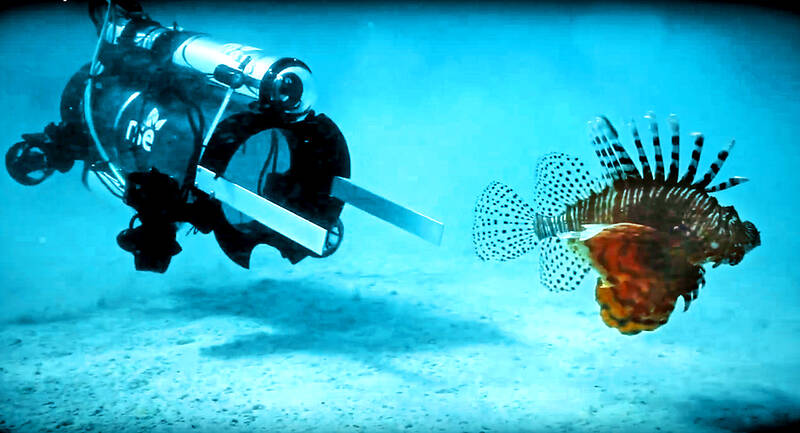Experts last week advised improving trade controls and awareness of biodiversity to mitigate the harm caused by invasive species, following the release of a comprehensive global report on biodiversity loss.
The landmark Assessment Report on Invasive Alien Species and their Control published by the Intergovernmental Platform on Biodiversity and Ecosystem Services on Monday last week found that the global economic cost of invasive species exceeded US$423 billion in 2019 and has at least quadrupled every decade since 1970.
In a video conference hosted the following day by the Science Media Center Taiwan, experts discussed the report and its implications for Taiwan.

Photo: Philippe Rouja / Courtesy of Robots in Service of the Environment via Reuters
Humanity relies on biodiversity, but once a species is lost, it can never be brought back, Academia Sinica Biodiversity Research Center fellow Chung Kuo-fang (鍾國芳) said.
For example, when the common water hyacinth was introduced to Lake Victoria in Africa, it wiped out many fish species important to aquaculture, he said.
The UN Convention on Biological Diversity last year advised island nations to be particularly cautious of invasive species, Chung said, adding that Taiwan has 63,758 recorded species, 243 of which are invasive.
Invasive species can also have a negative effect on human health, National Taiwan Normal University (NTNU) School of Life Science professor Kuo Chi-chien (郭奇芊) said.
For example, the Black Death was brought to Europe by flea-ridden rats following traders from Central Asia, eventually killing one in three people, he said.
The yellow fever mosquito, giant African snail, golden apple snail and mites are also disease vectors that have spread across the world, he said.
However, the impacts of invasive species vary widely, making it difficult to conduct a comprehensive assessment, Kuo added.
An immediate response is necessary to eradicate invasive species, National Dong Hwa University zoologist Yang Yi-ru (楊懿如) said.
For instance, the Hong Kong whipping frog — which is very similar to the endemic Polypedates braueri — was introduced to Taiwan many years ago, but no action was taken, Yang said.
It has now spread widely and is known to eat other frog species, she said.
On the other hand, immediate action was taken to eradicate poisonous cane toads, with cooperation from residents in Nantou County’s Caotun Township (草屯), she said.
Thanks to their years of hard work, it is likely to become the world’s first instance of successful eradication, Yang added.
The risks posed by cane toads are well-documented, but Taiwan still allowed its trade as a pet for many years, said Lin Si-min (林思民), who is also a professor at NTNU’s School of Life Science.
Taiwan is a hub of international trade, putting it at constant threat, Chung said, adding that it is important for the general public to understand the importance of protecting the nation’s ecosystems.
Yang said she has encountered many Taiwanese who adhere to a no-kill philosophy or refuse to remove more appealing species such as the Hong Kong whipping frog.
Explanation is necessary to communicate the harms they pose, as well as more humane methods of removal, such as chilling the frogs so they fall unconscious before they are killed as a “necessary evil,” she said.

Eight restaurants in Taiwan yesterday secured a one-star rating from the Michelin Guide Taiwan for the first time, while three one-star restaurants from last year’s edition were promoted to two stars. Forty-three restaurants were awarded one star this year, including 34 in Taipei, five in Taichung and four in Kaohsiung. Hosu (好嶼), Chuan Ya (川雅), Sushi Kajin (鮨嘉仁), aMaze (心宴), La Vie by Thomas Buhner, Yuan Yi (元一) and Frassi in Taipei and Front House (方蒔) in Kaohsiung received a one-star rating for the first time. Hosu is known for innovative Taiwanese dishes, while Chuan Ya serves Sichuan cuisine and aMaze specializes

Taitung County is to launch charter flights to Malaysia at the end of this year, after setting up flights to Vietnam and Thailand, the Taitung County Government said yesterday. The new charter flight services, provided by low-cost carrier Batik Air Malaysia, would be part of five-day tour packages for visits to Taitung County or Malaysia. The Batik Air charter flight, with about 200 seats, would take Malaysian tourists to Taitung on Dec. 30 and then at 12:35pm return to Kuala Lumpur with Taiwanese tourists. Another charter flight would bring the Taiwanese home on Jan. 3 next year, arriving at 5:30pm, before taking the

Taiwan High Speed Rail Corp. (THSRC) plans to ease strained capacity during peak hours by introducing new fare rules restricting passengers traveling without reserved seats in 2026, company Chairman Shih Che (史哲) said Wednesday. THSRC needs to tackle its capacity issue because there have been several occasions where passengers holding tickets with reserved seats did not make it onto their train in stations packed with individuals traveling without a reserved seat, Shih told reporters in a joint interview in Taipei. Non-reserved seats allow travelers maximum flexibility, but it has led to issues relating to quality of service and safety concerns, especially during

An exhibition celebrating Taiwan and Japan’s comic culture opened on Saturday in Taichung, featuring a section that explores Taiwanese reproductions of Japanese comics from when martial law limited Japanese representation. “A Century of Manga Culture: An Encounter of Taiwan and Japan’s Youth” held its Taiwan opening ceremony at Taichung’s National Taiwan Museum of Comics after an initial one-month run in Japan’s Kyoto International Manga Museum between May 24 and June 24. Much like the Kyoto exhibition, the show mainly celebrates the comic connection between Taiwan and Japan through late Taiwanese comic book